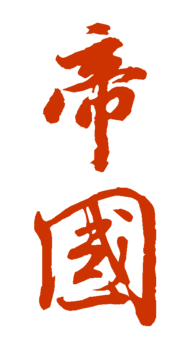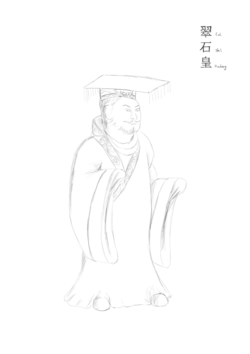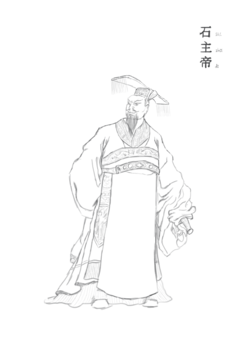Li-Ren
| ||||||
Distorian culture (Old Shíwén: 蒂国文化; New Shíwén: Dìguó wénhuà) is a farfolk culture which supposedly takes its roots from the distant empire of Distor (Dìguó). Due to the supposed vastness of this state, its customs and traditions are said to vary intensely across its entirety. As a result of lying on the very edges of the known realm, much of the documentation on the Distorian people and their culture is speculative, and many of which is fragmented. Known information about the culture has been taken from roughly translated firsthand accounts and unreliable tertiary sources.
Contents
Etymology
The exact etymology of ‘Distor’ is as shrouded as its very origins, especially as there are and have been various recognised names that have been given by outsiders, with names such as: Digo, Shigo, Eastum and Chitum - each with their own hypothesised origins.
One recognised root attributes it to the great trade leagues that once spanned across the seven seas. With ‘Distor’ sprouting as a distorted flexiosisation of ‘Dìguó’, the native name, directly translated to mean ‘The Empire’. With the suffix ‘-stor’ originating from Old Northeron for ‘great’; the language that first spun the great trade web.
Some speculate that the name is far older than the great trade leagues, and may have originally been ‘Distorien’, and have originated from Flexio. ‘Dist-‘ is an embryonic prefix found in Flexio, and is used to describe entities that are far apart. ‘Orien’ is not to be confused with ‘Oren’, as it means ‘East’ in Flexio. Although, these may be merely coincidental and have arisen from the fact that the Common tongue and Old Northern are both descendants of Flexio.
History
Founding of Distor
The great empire of Distor was unified before the 1000th year of the seasonal calendar and long before the measurement of time. Before then, the land was divided into states, led by their respective kings. These states had fought for control and dominance over land for hundreds of years prior to the founding of the empire. The state that would come to dominate all was the ‘Huáng guó’, roughly translating into the nation of glory and fire (Huīhuáng), ruled by the then named King Chéngzhēng (‘great conqueror’, Chénggōng zhēngfú).
Within 50 years, Huáng guó had conquered all neighbouring states, forming the ‘Dìguó’ (Distor) that has ‘survived’ to this day. Through this, King Chéngzhēng ascended to become Emperor Cuì (Cuì Shǐ Huáng, first Emperor of Cuì), and began what would be a short rule of the Cuì cháo (emerald dynasty). Under his rule, he applied a law of unification (yīfǎ), restructuring public, religious and governmental services. This led to a centralised road network, taxation system and army. The Empire’s law (Dìfǎ) was written and introduced during this period and still stands as the preliminary legal canon. The Emperor further abolished the wide-spread feudalist system that plagued his lands and instated a bureaucratic autocracy that would further validate his power throughout the empire. These developments would establish regulations that would last for 500 years.
Fall of the Cuì
The first blow to the Emerald dynasty came through Cuì Shǐ Huáng’s disregard for stability as he exerted his dominance across the newly formed empire, causing former noble men (displaced by the abolishment of feudalism) to grow in disdain against the Emperor - they would ultimately jump at any opportunity to retake what they thought was rightfully theirs.
This opportunity would come through the assassination of Cuì Shǐ Huáng, leading to unrest throughout the empire as pretenders to the throne laid claims to the Distorian throne; thereby threatening the very foundation of Distor and its unification. His heir, Tiānquán (Tiāndì quánlì, heavenly right), by will ascended to the throne as Cuì Èr Shǐ (second Emperor of Cuì); although many were suspicious of his legitimacy and saw him as a weak leader.
Within just two years of ascending to his throne, the final blow to the Emerald dynasty came when rebels stormed the imperial palace and killed Cuì Èr Shǐ. Distor collapsed into a state of civil war for 10 years, only to be resolved at the decisive Wǔjūn Zhànzhēng (5 armies battle) that saw the victor, Zhǔ Yǔ (Jiùzhǔ Yǔzhòu, saviour), ascend the throne.
Rise of the Shí
Zhǔ Yǔ ascended the throne to become Emperor Zhǔ of Dìguó (Distor) and founded the Shí cháo (Quartz dynasty), a dynasty that has lasted more than five hundred years and is strong even today. Shí Zhǔdì brought about peace to the empire, quelling the flames of the vassal states, and enacting peace with rival factions. His descendants would later end Distor’s isolationist stance, and finally welcome the world outside.
The fall of the Cuì served as a warning that the stability of the empire was far more of an importance than exerting dominance over its people. Shí Zhǔ Huáng understood this and divided the empire into 42 commanderies, each given a certain amount of power and military governance, as well as establishing an array of governmental roles from city magistrate to Prime Minister (Xiàngguó).
Under Shí Zhǔ Huáng’s glorious rule, he expanded the Distorian navy a hundred folds and supported exploration of the four seas, this saw the discovery of many lands from Xīzhōu (Western island) to Sìdǎo (‘four-islands’ isles, more commonly known as Axios); thus opening up diplomatic communications with foreign entities for the first time.
The great emperor died in 1013, after 44 years of rule, the cause of death is still vague to this day but many attribute it to illness. Before his death, he had supposedly ordered the construction of a vast tomb complex containing an expansive stone army in order to protect and serve him in the afterlife. The exact location of the emperor’s tomb is not known, but many speculate that it is located far from Dìguó in order to protect the valuables that were also locked with him.
Fashion
Garments
Fashion in the Shíguó has the smallest degree of variance in Distorian culture, with both commoners and government officials wearing similar styles of clothing, with the only distinguishable features being the colour and quality of the garments. Silk is considered the material of choice by high ranking individuals, chosen for its smooth and slippery texture as well as its ability to stay cool to the touch in the warm Shí climate. Vividity and variety of colours used in a piece of garment were used as indicators of wealth, as they showed that the wearer was able to afford for the greater array of dyes. Both male and female garments were adorned with embroidery, with wealthier individuals being able to afford for more detailed and larger works on their garments.
Traditional Shí clothing is referred to as ‘shífú’, for men it consists of a ‘shēnyī’ (a long coat or robe) and a ‘zhōngyī’ (shirts and trousers). The shēnyī is a robe-like garment that covers the entirety of the wearer’s arms, and reaches to their feet, it is generally worn in more formal confrontations. The zhōngyī is worn underneath the shifu and is mostly made of cotton or silk.
The most common garment worn by women is a ‘rúqún’, consisting of a long skirt and an upper garment, decorations such as braids or ornaments may be worn with these.
Hairstyles and Head-wear
Both male and females refrain from cutting their hair once they have reached adulthood, between the ages of 15 to 20, allowing their hair to grow long. This follows the ideas and teachings that every inch of an individual is a debt to their parents and to God, that they are of their parent’s flesh and blood; thus to cut your hair is to dishonour your family. The shaving of hair is a common punishment considered equivalent or worse than death.
With the changing of fashion throughout the ages, many different styles of hair have come and go, such as the xiàfǎ, sānfǎ, and yuánfǎ. These hairstyles would be accommodated with various hair accessories as ornaments for the hair, such as hair pins (jiā, which were also used by males) in order to hold their hair in place. It is also common for females to leave their hair down before marriage.
On the other hand, men are only allowed to tie their hair into a knot (jì). The fútóu, a cloth wrap around the hair is the most common headwear for men.
Society
Distorian society consists of rigid hierarchies, present at all levels of social interactions. Since Distor's inception, the Emperor has ruled above all else, below which are military officers and government officials. With much of the central focus in society being on literary arts and education, advancements in society is achieved through merit. A system by which rewards are handed out purely on the basis of good and outstanding contributions, regardless of other variables such as prior affluence. Both members of the military as well as scholars would have to pass examinations to achieve greater standings in society. Although, it is generally the case that the wealthiest families are able to fund for better education, and therefore provide an unfair advantage to their own.
Language
The language of the Shí is known as 'Shíhuà', its can be found in two written forms: New Shíwén, and Old Shíwén. New Shíwén was introduced 200 years ago by linguist Qian Jiegang in order to improve communication with the outside world and vastly improve literacy rates amongst the Shí people, it is a flexiosisation of the Shíhuà (Shí tongue). Despite Shíhuà being the official language of the Shí, the 'Common' tongue has become more widespread among the Shí people, and Old Shíwén has vastly died out.
Identity
An individual’s name consists of their family name (xìng) and personal name (míng), in some circumstances it is seen as being disrespectful to use personal names. Family names originate from clan names and are patrilineal, passed from father to child. Sub-surnames are given to government officers in order to distinguish between ranks and seniority, this is known as a ‘shì’. Personal names are given by parents to have a meaning, they are generally used as a blessing on their child. In formal consultations, the xìng comes before the míng, which is followed by their shì and title.
Example: Yíng (xìng) Zhēng (míng) Meng (shì) Taishi (grand historian), meaning 'to bring success'.
Five Principles
Known as the Wǔyuán, these principles consists of the five elements and the five colours, representing the idea that certain forms are imbued with values and characteristics. Distorians utilise this principle in everyday life, eminent in all decorative forms - the most common of which is fashion.
Five Elements
These elements are known as the Wǔyuán (five principles) and are water (shuǐ), metal (jīn), earth (tǔ), fire (huǒ), and wood (mù). They are believed to be the source of all things in the realm, and are the undermining values in all concepts. The Wǔyuán are present in almost all Eastern cultures, being established from perhaps the beginning of time; although they are known differently by the Hatamoto and the Chiyoko.
Earth represents balance, and is portrayed by the colour yellow. It is believed by the Shí people that life is a cycle and that people are born from the earth and return to the earth when they die. It also represents the centre of all things in the universe, and a passage to the divine world.
- Water is an element of neutrality, but also represents the cold and winter climate. The black tortoise is used to depict the north in Distorian and Eastern folklore.
- Wood is used to represent the beginning of life; thus is used to characterize spring and used as a symbol in agriculture in order to bring good fortune to crops.
- Fire of course associates itself to heat and warmth, from this it is used to depict summer. The vermilion bird corresponds to the south, where the climate is generally far warmer.
- Metal is coupled with the colour of white, and used to represent divinity. This stems from the ancient use of meteoric iron, linking the Earth to the aether above.
Five Colours
The principle colours are concepts established from the five elements, they are:
- White (bái),the colour of the Shí (quartz), representing brightness, purity and harmony.
- Yellow (huáng), the colour of the emperor (Huangdi). Distorian legends tell of the first men being moulded from the clay and silt in the yellow river (Huanghe). It is said that only the emperor may use the colour yellow, as it represents his divine right over the Shí people.
- Green (lǜ), the colour of the Cuì (emerald), representing wealth, strength and health (somewhat ironic).
- Red (hóng), associated with fortune and happiness, it is used extensively in celebratory events like weddings and festivals. Doors are pasted with red papers with blessings, and red lanterns adorn streets in order to bless those who pass by.
- Black (hēi), regarded as the colour of neutrality, some consider it as the colour of the heavens, as daylight is blue and the night sky is black.
Random Tidbits
- There are various interchangeable terms whose usage varies between texts, i.e. a foreigner may use 'Distor', whilst a Shí loyalist may use 'Shíguó'.
- Distor is heavily influenced by Middle China, between the Qin and Han dynasties (considered the founding dynasties of China).
- Adapted from Distorian and Eastern Culture


